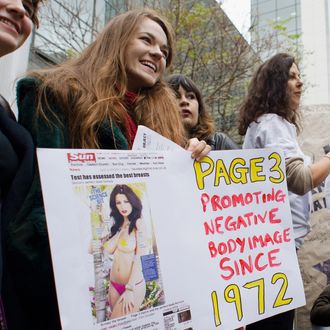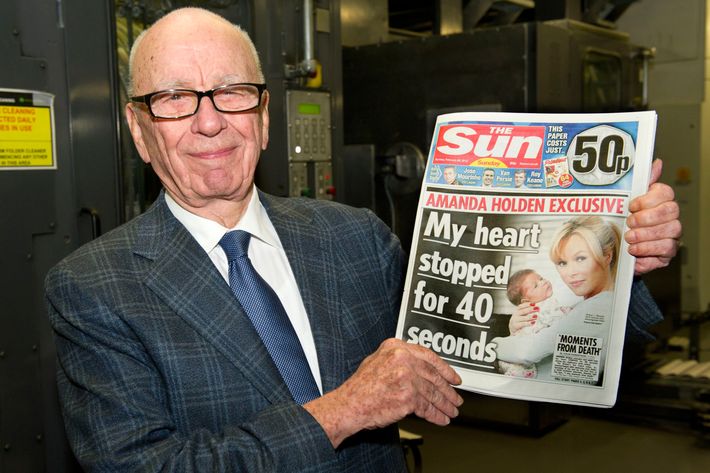
In a masterful display of media trolling, the popular British tabloidThe Sun managed to convince everyone on Tuesday that it would no longer be publishing photos of topless models, a controversial practice it’s steadfastly defended for 45 years. Though “Page 3” will still feature scantily clad women, reports said, they’ll get to wear bras and underwear instead of going nude, much to the chagrin of pervy old dudes on the tube.
Many British officials and citizens voiced their support for the seemingly sudden decision, while some former “Page 3” models blamed the new ban on censorship-loving feminazis. On Wednesday, The Sun revealed the whole thing to be a hoax with a single tweet.
But how did we go from running topless photos of 16-year-old girls in a widely read newspaper to far-flung disapproval of a feature many deemed sexist and demeaning? Here’s a brief history of Britain’s most notorious newspaper feature.
November 1970: The Sun relaunched in November 1969 under new ownership. Helmed by Australian media magnate Rupert Murdoch and editor Larry Lamb, the tabloid launched its first nude “Page 3” spread on November 17, 1970. It was one of the first times nude photos of women had appeared in a newspaper as pure entertainment. The move immediately sparked controversy and anti-pornography protests — some local libraries even refused to carry it — but Lamb used this outrage to stoke discussion of The Sun’s redesign and raise its profile.
1971: Within a year of publishing the topless photos, The Sun’s circulation almost doubled to 2.5 million.
The ‘70s and early ‘80s: The Sun continued to publish photos of nude and near-nude women on “Page 3,” but tried to find a healthy balance between catering to its sex-obsessed audience and not offending women. According to the BBC:
The pictures were generally shown to women reporters on the paper to make sure that female readers wouldn’t regard them as horrible or “dirty”. And it was always said that the model’s smile was more important than anything else.
Mid ‘80s: The Sun started to show more skin, and its first (and pretty much only) star was born. Samantha Fox began posing for “Page 3” in 1983 at the age of 16 when she signed a four-year contract with the paper. Through her modeling and other side projects, Fox became one of “the most photographed British women of the 1980s,” and is by far the most well-known “Page 3” girl. Fox’s success contributed to the narrative that “Page 3” provided a popular platform for young women to break into the modeling world. As the BBC wrote in 2000, Fox represented “a new type of Page Three girl who instead of being merely pneumatic had a personality of sorts: brash, tarty, clothes-and-money-mad and the ultimate fantasy girlfriend for ‘80s Essex Man.”
1986: The more popular “Page 3” became, the more scrutiny it began to court. In 1986, Clare Short, a member of Parliament, proposed a bill that would ban newspapers in the U.K. from publishing pornographic images. The bill was slow to gain support and died on the floor. Short quickly became a favorite target of “Page 3.”
1999: Perhaps foreseeing a world inundated by internet porn, The Sun launched Page3.com, its new online portal for photos of “Page 3” models, after pushing a number of print redesigns in the ’90s.

2003: In January 2003, Rebekah Brooks — then known as Rebekah Wade — became the first female editor of The Sun. Many expected her to scrap “Page 3,” but she came to staunchly defend it.
2004: The Sun published a picture of Clare Short’s face Photoshopped onto the topless body of a “Page 3” girl and called her “fat” and “jealous.”
2011: At a conference of Liberal Democrats in Birmingham, many voiced their desire to ban “Page 3” and other features like it. “Tabloid newspapers in particular, which call themselves family newspapers, should not be able to portray women in a sexualised way, in a way that the broadcast media would not be able to do in soap operas and children’s television programmes before the watershed,” one member of Parliament said.
2012: An activist named Lucy-Anne Holmes launched the “No More Page 3” campaign, sending letters and petitions to British officials asking them to ban “Page 3.”
March 2013: A Twitter campaign organized by “No More Page 3” and directed at Rupert Murdoch finally got the aging media mogul to comment on a potential new direction for “Page 3”: “you may be right, don’t know but considering,” he wrote. “Perhaps halfway house with glamorous fashionistas.”
June 2013: Green member of Parliament Caroline Lucas ignored Westminster’s dress code, showing up to a governmental debate on media sexism in a “No More Page 3” T-shirt.
August 2013: The Irish version of The Sun stopped running topless women on “Page 3.”
September 2014: Another crack in the Murdoch facade appeared when he called the “Page 3” institution “old-fashioned.”
January 20, 2015: The Sun quietly published what many believed to be its last nude model on Friday, January 16. On Tuesday, The Times, another Murdoch-owned publication, said that “Page 3” would no longer include nude models, instead featuring those wearing underwear or bathing suits.
January 21, 2015: The Sun admits it was all a troll, tweeting a picture of Thursday’s “Page 3” displaying a topless woman winking knowingly and the following text:
Further to recent reports in all media outlets, we would like to clarify that this is Page 3 and this is a picture of Nicole, 22, from Bournemouth. We would like to apologise on behalf of the print and broadcast journalists who have spent the last two days talking and writing about us.





























